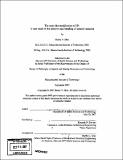| dc.contributor.advisor | Kenneth N. Stevens. | en_US |
| dc.contributor.author | Zhao, Sherry Yi, 1980- | en_US |
| dc.contributor.other | Harvard University--MIT Division of Health Sciences and Technology. | en_US |
| dc.date.accessioned | 2008-11-10T19:57:35Z | |
| dc.date.available | 2008-11-10T19:57:35Z | |
| dc.date.copyright | 2007 | en_US |
| dc.date.issued | 2007 | en_US |
| dc.identifier.uri | http://dspace.mit.edu/handle/1721.1/42205 | en_US |
| dc.identifier.uri | http://hdl.handle.net/1721.1/42205 | |
| dc.description | Thesis (Ph. D.)--Harvard-MIT Division of Health Sciences and Technology, 2007. | en_US |
| dc.description | Includes bibliographical references (leaves 138-142). | en_US |
| dc.description.abstract | Phonetic variation is pervasive in everyday speech. Studying these variations is essential for building acoustic models and lexical representations that effectively capture the variability of speech. This thesis examines one of the commonly-occurring phonetic variations in English: the stop-like modification of the dental fricative /ð/. This variant exhibits a drastic change from the canonical /ð/; the manner of production is changed from one that is fricative to one that is stop-like. Furthermore, the place of articulation of stop-like /0/ has been a point of uncertainty, leading to the confusion between stop-like /ð/1 and /d/. This thesis aims to uncover the segmental context of stop-like /ð/, possible causes of the modification, whether the dental place of articulation is preserved despite modification, and if there are salient acoustic cues that distinguish between stop-like /ð/ and /d/. Word-initial /ð/ in the read speech of the TIMIT Database, the task-oriented spontaneous speech of the AEMT Corpus, and the non-task-oriented spontaneous speech of the Buckeye Corpus are examined acoustically. It is found that stop-like /ð/ occurs most often when it is preceded by silence or when preceded by a stop consonant. The occurrence is less frequent when /ð/ is preceded by a fricative or an affricate consonant. This modification rarely occurs when /ð/ is preceded by a vowel or liquid consonant. The findings suggest that possible factors that may contribute to the stop-like modification of /ð/include physiological mechanisms of speech production, prosody, and/or other aspects of speaking style and manner. Acoustic analysis indicates that stop-like /ð/ is significantly different from /d/ in burst amplitude, burst spectrum shape, burst peak frequency, and second formant at following- vowel onset. | en_US |
| dc.description.abstract | (cont.) Moreover, the acoustic differences indicate that the dental place of articulation is preserved for stop-like /ð/. Automatic classification experiments involving these acoustic measures suggest that they are robust in distinguishing stop-like /ð/ from /d/. Applications of these findings may lie in areas of automatic speech recognition, speech transcription, and development of acoustic measures for speech disorder diagnosis. | en_US |
| dc.description.statementofresponsibility | by Sherry Y. Zhao. | en_US |
| dc.format.extent | 160 leaves | en_US |
| dc.language.iso | eng | en_US |
| dc.publisher | Massachusetts Institute of Technology | en_US |
| dc.rights | M.I.T. theses are protected by
copyright. They may be viewed from this source for any purpose, but
reproduction or distribution in any format is prohibited without written
permission. See provided URL for inquiries about permission. | en_US |
| dc.rights.uri | http://dspace.mit.edu/handle/1721.1/42205 | en_US |
| dc.rights.uri | http://dspace.mit.edu/handle/1721.1/7582 | en_US |
| dc.subject | Harvard University--MIT Division of Health Sciences and Technology. | en_US |
| dc.title | The stop-like modification of /ð/ : a case study in the analysis and handling of speech variation | en_US |
| dc.type | Thesis | en_US |
| dc.description.degree | Ph.D. | en_US |
| dc.contributor.department | Harvard University--MIT Division of Health Sciences and Technology | |
| dc.identifier.oclc | 230822952 | en_US |
